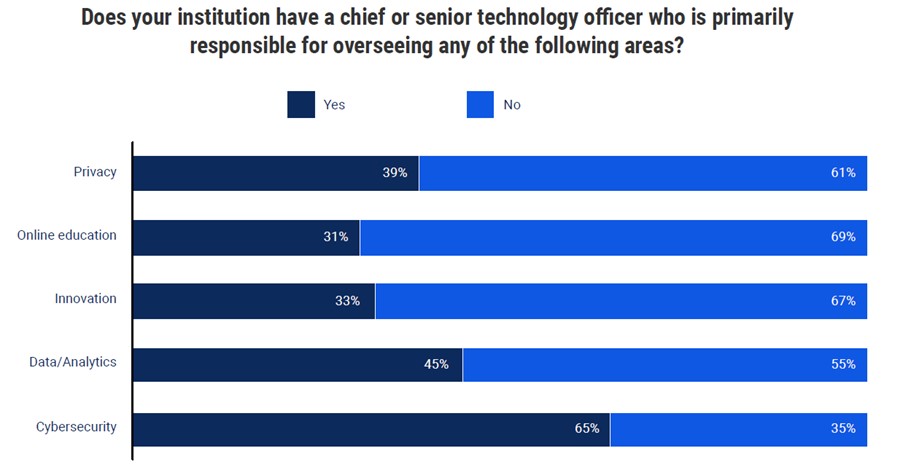The recently published findings of Inside Higher Ed’s 2022 Survey of Campus Chief Technology/Information Officers, its first-ever such survey, holds some important lessons for senior staff in UK universities, I believe.
It’s a technology survey of 175 US-based senior technology leaders on campuses—most of whom carry the title of either chief information officer (CIO) or chief technology officer (CTO).
Lesson one: post-pandemic, two thirds of the responding institutions now have a CIO/CTO on the president’s cabinet. Those that do are far likelier than their peers to say that their institution has made digital transformation a priority (52 percent versus 24 percent). In other words, if you want to digitally transform your institution, you need top-level administration representation and decision-making empowerment.
Lesson two: 70% of the surveyed respondents said that senior administrators at their college treat the IT unit “more like a utility than a strategic partner”. From our experience of working with successful online programmes and institutions, this is a big mistake, and can be an expensive one. Heriot-Watt University’s early investment in its online MBA programme and production team has seen a return in excess of £200m over the past 25 years. The same production team went on to deliver other successful postgraduate and undergraduate programmes, all derived from the same initial investment in production capability – people and technologies.
While such spectacular returns are unlikely for most online programmes today, profitable online programmes are well within reach, particularly if the investment made into producing them is also spread over on-campus use, to enable better quality delivery and more flexible course scheduling. More ‘bangs for the buck’ so to speak.
The opportunity for such investments has now matured, however, and moved up to the institution level where strategic deployment across all departments and subjects is next. This is a bigger challenge, not just because of the institution-level culture-changing aspect, but also because the enterprise-level technology issue is more holistic, architectural and multi-generational.
Implementing a semantic information architecture for all digital learning materials and didactic publications is a challenge, but one that most senior librarians are capable of overseeing with initial help. Building the tools, teams and processes to manage your digital assets domain of thousands of courses and tens of thousands of course components, possibly in multiple languages, is also a big challenge that needs initial help. Actively valuing and promoting a commitment to them internally and to new staff members is also important if you want to avoid semantic erosion and loss of investment.
Lesson three: while being generally upbeat about their college’s ability to offer high-quality virtual instruction, most of the surveyed technology leaders don’t believe their institutions give instructors credit for digital pedagogy or teaching with technology. These capabilities too are a necessary component of a successful digital transformation. The survey also sought to understand institutions’ structure for managing the role of technology. In the example of “online education”, an average of two-thirds of respondents said their institution does not have a senior officer responsible for online education.

Source: Inside Higher Ed 2022 Survey of Campus Chief Technology/Information Officers
I felt this was very revealing given that post-pandemic, information technology is assuming a larger and more central role in learning and campus operations.
The survey also touched upon whether the investment in such technological capabilities should be centralised or left to individual departments to oversee. It found that about four in five CTOs reported that their central IT unit had more employees than were managed by disparate units at the institution. So, a degree of centralisation is present in most institutions, but to what extent and doing exactly what?
Virtually all CTOs are responsible for administrative technology, telecommunications and academic technology, while between two-thirds and three-quarters of CIOs overall say they also provide support for online education, media services, institutional research and campus teaching and learning centres. This is quite a ‘shopping-list’ of systems and responsibilities, but it is missing a key one, probably because its new.
The digital transformation process creates a new domain of digital assets. These are costly to create, but one would hope are produced smartly to be reusable and independently formatted, so there is no need for proprietary systems or licensing. Even for an average institution there are tens and easily hundreds of thousands of assets, and they need to be cherished and maintained.
Assets aren’t just image or text files, but also complete publications, apps, competency frameworks, custom packages and distributables and the important metadata about them, including ownership, subject relevance, usage data and update versioning. In other words, the institution is about to get substantially involved in Information Management – something OPM partners have been quietly doing ‘on the fly’, which usually only becomes apparent when a partnering agreement ends and the institution is left with nothing tangible other than original author files.
Lesson four: the vast majority of CIOs (84 per cent, of which 51 per cent strongly) agree that they are struggling to hire new technology employees, and most (62 percent, of which 27 percent strongly) say they’re struggling to retain employees.
In our experience, you only really need such expertise when initially designing and implementing the information management solution that will underpin your digital transformation. Once that is done, you can use more administrative trained staff to use the new tools to create the technically sophisticated digital products in a templated, standardised yet still pedagogically flexible way.
In other words, you don’t need to hire and retain lots of programmers and learning designers once your information architecture and domain are established, proven with students and tutors, updated and well maintained. Both MiT (EdX) and the UK Open University are well aware of this, having already made substantive investments into creating their own domains of reusable (XML) based course materials, teams and processes.
Lesson five: relatively few of the surveyed CIOs say their institutions are serious about cutting-edge technologies. Of those listed, including the current hot-topics of quantum computing and artificial intelligence, some key ones are missing for me. I suggest digital transformation, information management and online distance learning production are actually a more fruitful areas of cutting-edge technology to invest in heavily in the short-to-medium term. Learn to do these together, and well, and your institution might just find itself at the top of the global online education game.
Great survey. Very relevant and thought provoking.

